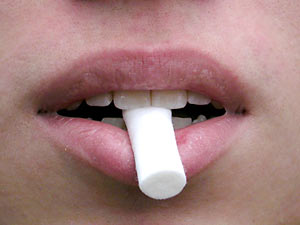Self-test
 You can conduct following tests yourself at home in order to determine dysfunctions in head, jaw, neck, and shoulder areas as well as pain and the probability of CMD:
You can conduct following tests yourself at home in order to determine dysfunctions in head, jaw, neck, and shoulder areas as well as pain and the probability of CMD:
| yes | no | ||
| Are you missing teeth or do you have a bridge? | |||
| Do you have big or worn out fillings in your side teeth area? | |||
| Mirror control: Does the mouth open straight? | |||
|
|||
| Are the teeth stamped on the right and left side of the tongue? | |||
| Do you monitor a knack or rubbing noise in the area of the jaw joint and ear while opening and closing the mouth? | |||
| Is mobility of the lower jaw restricted e.g. small mouth opening? | |||
| Do you have the feeling that your alignment does not fit on one another (Incorrect bite)? | |||
| Do you grind or press your teeth together? | |||
| Do you feel pain in the ear and jaw joint region? | |||
| Do you suffer from pain while chewing or/and opening your mouth? | |||
| Do you suffer from frequent headaches or migraines? | |||
| Do you hear unusual ear noises or do you suffer from tinnitus? | |||
| Do you experience tension in your neck and/or shoulder muscles? | |||
| Can you turn your head in half circle without pain? | |||
| Are your head muscles uptight or even painful while applying pressure? | |||
| Do you experience a feeling of imbalance or dizziness? | |||
| Do you suffer from insomnia (Snoring, breathing failure)with daily fatigue? | |||
| Have you ever had an accident or damages in your head/neck area? |
Downloading questionnaire as pdf document
If you should answer more questions with “yes”, it´s reasonable to contact a diagnosis and therapy CMD specialised dentist and to clarify treatment requirements.
Important reference: An examination of the chewing system as prophylaxis of CMD is always feasible, if an extensive dental treatment e.g. with crowns, bridges or dentures is planned, an orthodontic or implantologic treatment. If a therapeutic sleeping bracket “snoring bracket” even must be applied, then a CMD examination must take place in order to detect risks before beginning a therapy and to take into consideration.
Extended „Mersemann“-Test
Test I:1. Stand upright (possibly barefooted), so that your body weight is spread evenly on both feet and watch in the mirror the position of your shoulders and remember it – biting your teeth together tightly.
2. Then open and close your jaw consciously and remember which teeth touch each other first.
3. Afterwards place a cotton role between the upper and lower front teeth and walk around with it for about 5 minutes, changing walking direction several times.
4. Afterwards watch your body posture (holding the cotton roll in your mouth) in the mirror and compare this to your prior posture.
5. At the end take the cotton roll out of your mouth and close the jaws consciously slowly – if totally other teeth touch each other than before, then it is “biting” evidence of CMD.
 Test II:
Test II:1. Lean hardly with your back against a wall and turn your head with pressed teeth (alignments) together as far to the left and the right until you experience a sense or pain.
Remember how far you could turn your head.
2. Then you place a cotton roll in your mouth again as in test 1 and walk as described above.
3. Afterwards lean with the cotton roll in your mouth, hardly with your back against a wall and determine how far you can turn your head to the right and left without experiencing pain.
4. Compare this with your prior turning of the head
You can complete this test (restricted) also on other CMD symptoms (see prior listing).
However, you will need a much longer contact time, of the affected bite suspension, so that a 5 minute test, which does not affect anything, which is not a sign against CMD.
Do you experience a change even after a small contact time, then this is already evidence of a CMD.
